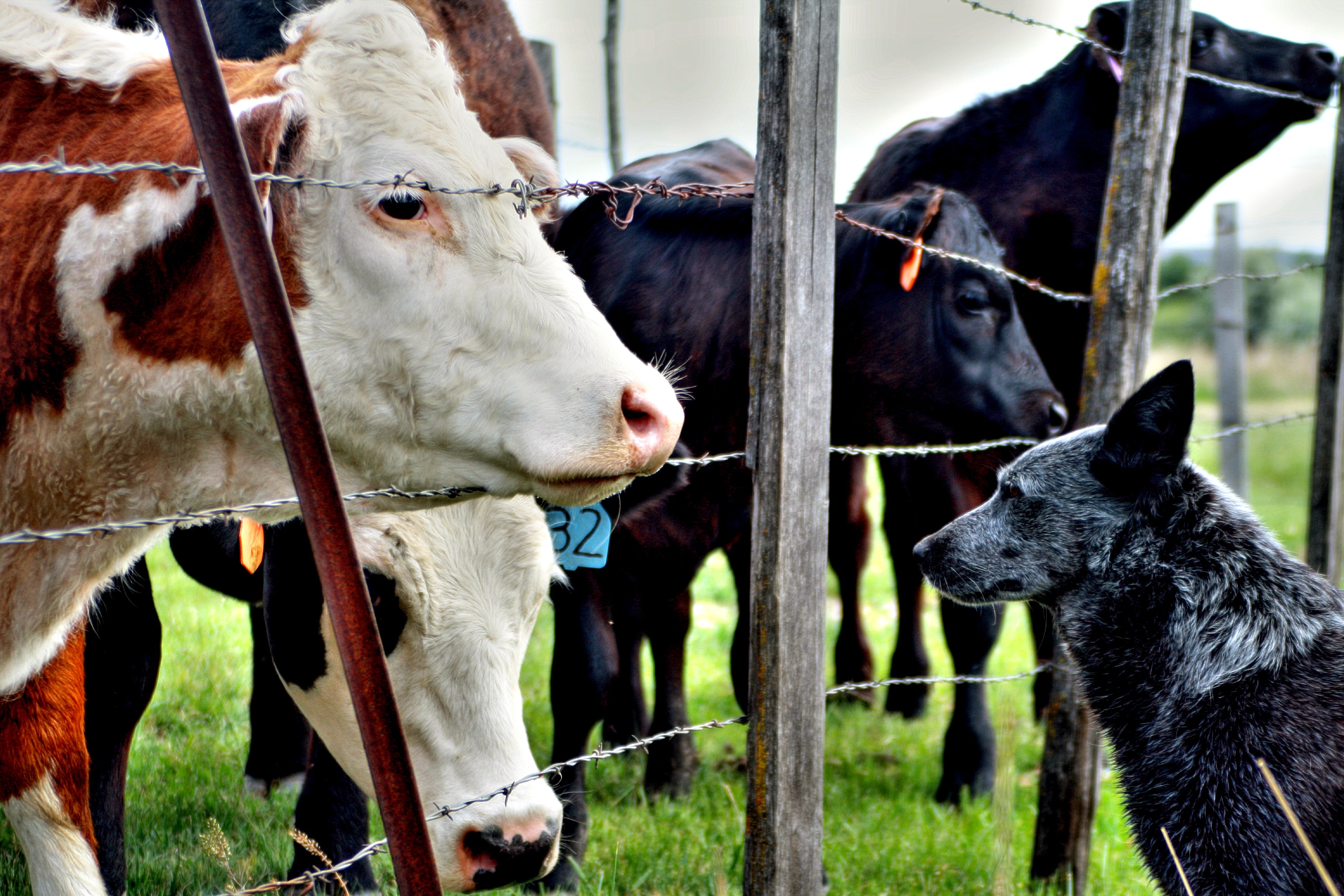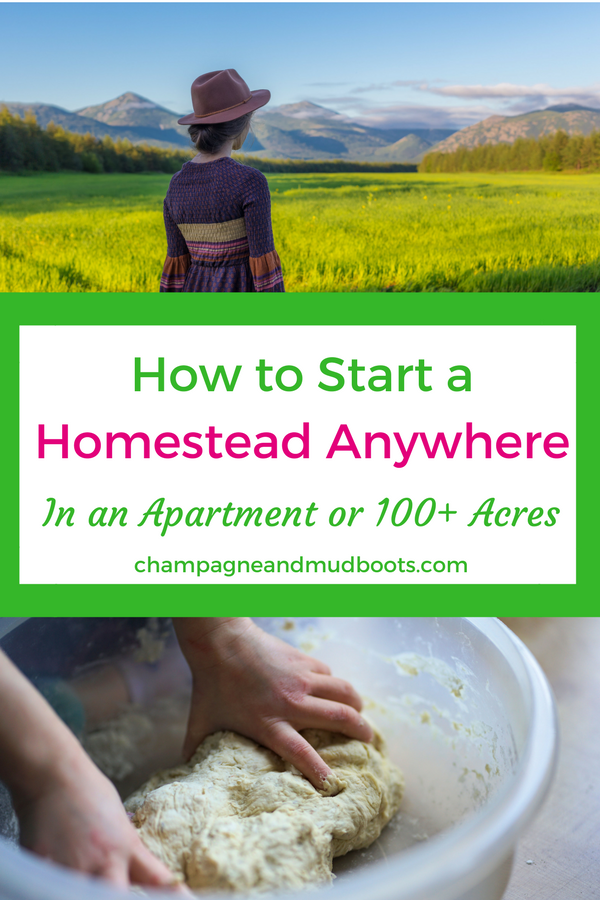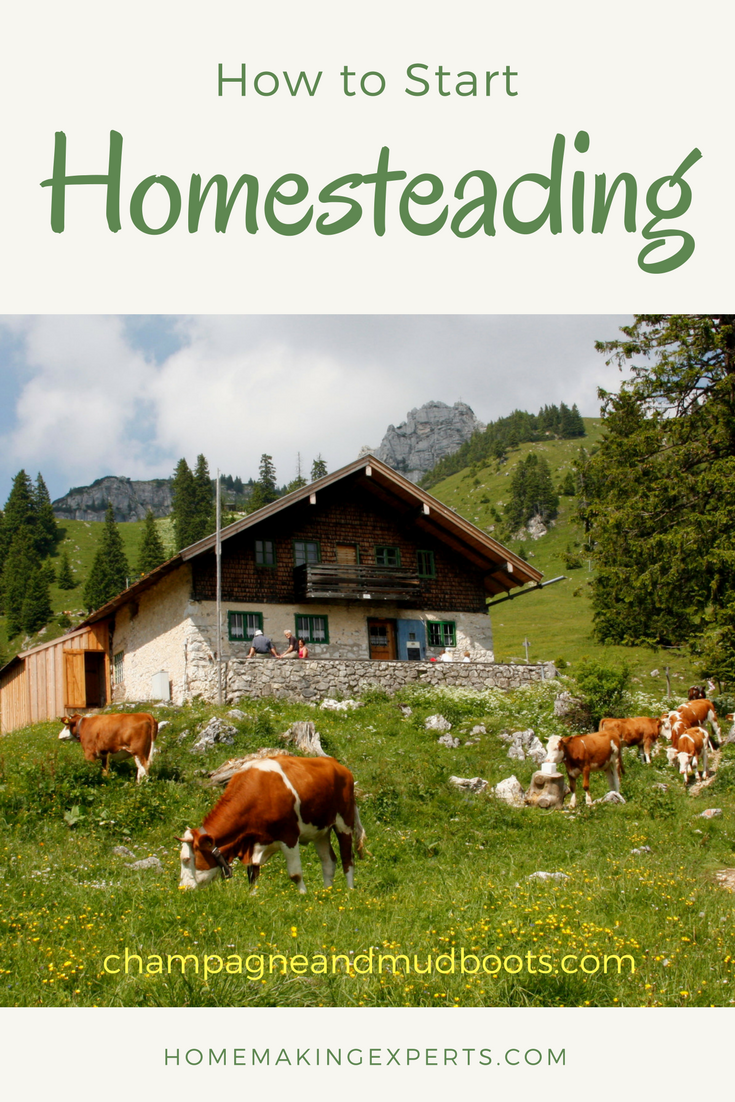You may have toyed with the idea of homesteading with your own gardens and animals. You’ve seen Chip and Joanna’s chicken coop and felt pangs of envy or pictured your own farm to table dinner party. How do you even begin to make this happen though, especially if you’ve been a city dweller all your life? I’ll give you the steps you need for how to start homesteading whether you have a rented apartment or 100+ acres of land.
Step 1: In the first step you get to dream a little. It’s time to think big and layout your vision.

I think sometimes it gets portrayed as you have to check all these boxes (gardening, butchering animals, building all your own buildings, sew all your clothes, live off grid, etc) to consider yourself a real homesteader but there are no rules. You get the freedom to choose what you want do with your land to help you be a little more self-sustaining and create the lifestyle that is perfect for you.
So that being said what is your vision for your homestead? Do you want to grow as much of your own food as possible? Are you planning to raise and slaughter meat? Or are you dead set against raising your own meat? You can have a perfectly good homestead without killing things. Hell, it can be a total vegan homestead and be awesome. You do you!
Where do you want to live? Do you want lots of land or just an acre that is out a little farther from the city? Do you want to live out in the country or on the edge of it? Check out this post on Why the Suburban Rural Fringe is the Ideal Location for a Homestead!
Bear in mind, no matter the location, look into local regulations as these may put a real damper on your homestead dreams and goals. It’s better to know ahead of time before you buy land.
What about your loved ones? What do they want and/or need? No use dreaming of off grid if your spouse says over their dead body! How can you compromise to get what you want?
The design and dreaming part is fun. You can go full tilt vision boards and all. Be aware that your ideas of perfect will change as you begin to homestead and decide which parts you enjoy and what you’d rather pill a feral cat for a week than do again. Nevertheless, you need a vision to aim for in the beginning.
Step 2: Get your finances in order

Poof! Dream time is over and it’s time to get real people. This step is not glamorous and doesn’t have any of the fun farm things in it. This is where the real work begins.
Homesteading doesn’t have to be expensive if you plan on lots of DIY and don’t have to have everything new or right away and you’re willing to compromise. I tend to have expensive taste though, and while I don’t need a Louis Vitton purse, I do want a big tricked out chicken coop which depending on the size of the bag will run you about the same cost.
Look at the vision you planned out and start trying to come up with some real-world numbers. Price out land in the area you want to live. This number can vary significantly depending on the region of the country.
If you are willing to relocate you can often find much cheaper land. You have to weigh pros and cons of relocation. Where are your family and friends and do you want to be close to them? Does your job require a specific location or can you work remotely or change jobs?
Once you’ve got some numbers to work with you can begin to look at your financial situation. Consider what you’ve got in savings and any home equity you may have that you can put towards land. Small little low cost upgrades like paint and proper staging can help with resale value on your home.
At this point the budget discussion may be more depressing than you anticipated but don’t worry your homesteading dreams are not crushed forever. Check out my 50 Ways to Save on a Homestead for ideas to save money both before and after you purchase your homestead.
The next steps assume that you have purchased a property or are going to start the homesteading lifestyle in your current location.
Side note Steps 3, 4, and 5 can really be interchanged depending on what you prefer to do.
Step 3 Gardening

Plan out your first garden. If you are an experienced gardener you can dive right in and start but 10 Steps to an Awesome Vegetable Garden is a great place for beginners to start.
Think about what you want to grow and what you will actually eat. This is another of those dreaming scenarios where you plan out all the stuff you would like to grow then scale back based on time and space. I recommend starting smaller if you’ve never gardened before so you are not overwhelmed.
Apartment dwellers: Herb gardens can be placed on windowsills or patios. Depending on your sunlight you can get tomatoes to grow in pots on the patio. Malabar spinach will grow in a pot and climb a trellis on your porch. A few grow lights indoors can get you a micro-green mini farm going right in your apartment. Fresh salad year-round!
Suburbs: You can add in simple raised beds to your backyard that still allow for kid play areas if needed and check out this fence post for ideas on a covered raised bed to protect them from you dogs.
Edible landscaping can make your suburban home an attractive food producer. Many edible plants provide good color and provide beautiful landscaping keeping you within HOA regulations.
It is both shocking and sad how often edible gardens in a front yard land people in court. The real criminal offense is encouraging people to have perfect chemically treated water guzzling grass in the yard but I digress.
Fruit trees can be added to either the front or backyard. Pruning full sized trees to a small size allows multiple trees in a very small area. Check out Jeff Lawton and backyard permaculture. Further proof you don’t need acres of land to be a homesteader.
Acreage: This is often the dream of many a homesteader. The freedom of lots of space, potential, and a retreat from the daily grind. The sky is often the limit for gardening but make sure you can handle the size of garden you’ve planned out.
You also don’t want the garden too far away. You won’t take care of it the same if you have to walk an acre to see it versus if it’s close to the back door.
I would also plant at least a few fruit trees the first year you move in. You likely won’t have the whole design of the farm worked out but since it takes a few years for trees to produce the sooner you get them in the ground the sooner you can have produce.
You can plant more each year but get something started so you aren’t behind the game on this one. I know because I got way behind on this one.
Step 4. Livestock

Apartment: This is a hard one. Livestock and apartments just are not a great combo. You are really limited to trying to keep something like quail at an off sight location but you’ve got to be able to check on them daily to every other day and to me I think time is better spent figuring out ways to save and earn money to have a larger place if you really want livestock.
Suburbs: Livestock in the suburbs is really about what you are “allowed” to have and depends on how closely you follow the rules. Many cities allow chickens as long as you don’t have Roosters. There is often a hen limit and possible noise ordinances. Check out my How to Raise Chickens and Avoid Salmonella Contamination post to learn the best ways to prevent this infection especially in closer quarters like a backyard.
One possible advantage to chickens is you don’t necessarily have to kill them to get a product but decide in the beginning are you keeping pets that you will have for years even if they are not producing eggs or are they headed for the stew pot when production stops?
Rabbits: rabbits give lots of meat and reproduce very quickly! The are fairly quiet and if the neighbors just see a hutch with the same color rabbits in it there aren’t a whole lot of questions regarding it. However, the downside is you have to be okay with slaughtering your own bunny. Some people can do it,others can’t.
Quail: These little guys have a very fast reproduction rate, give both eggs and meat and you can raise them in close quarters. They were bred to live in cages although aviary systems can work. There is also less attachment to these guys than bunnies so butchering is easier.
Aquaculture: Raising fish like tilapia in a tank with attached grow beds can be a convenient way to produce a meat source and grow some veggies. An added bonus is fish are quiet so they are not an animal that will bother the neighbors in close suburban quarters.
Acreage: Again, choices abound the more land you have available for use. All those already mentioned chickens, quail, rabbits, plus goats, pigs, cattle, alpacas, sheep.
Look for breeds that fit what you need/want. Different breeds provide better output for dairy versus meat or other products. You may be able to wait and find a deal on an animal that is the breed you want or if you are flexible on the breed you may find it faster.
If accepting free or price reduced livestock be sure that the animal is truly healthy. You may not be saving much in the long run if it has multiple problems. Animals used for breeding stock should have good confirmation and good health. It’s not saving you money if your cow to breed always throws twins or triplets that die.
If the animal is destined for freezer camp just make sure it can make it to freezer camp without too many issues.
Step 5: Self-Reliancy

You can begin these steps anywhere. The basic idea is to prepare yourself so that in an emergency you aren’t just waiting around for help. You can begin helping yourself. I give many ideas for this in my Ultimate Guide to Homestead Emergency Preparedness.
If you are in an apartment you may not need a cattle trailer to move livestock if you have an emergency but do you have a plan to evacuate your dog if needed or have someone to call to water your plants if you had to leave town unexpectedly? What if your water was shut off, do you even have safe water to drink or are you going to be at the grocery store fighting over a pack of Ozarka?
Step 6: Always keep learning

It’s never been easier to homestead than in today’s world where YouTube and various websites can teach you how to do just about anything on a homestead. This makes it possible for even the city slicker to learn how to manage their farm.
It takes time though and constant learning. One of the hardest things about homesteading is really the time factor. You probably won’t have hours to spend watching TV especially if you are working off the farm and trying to homestead.
Accepting that your free time will be filled with research and learning for a new project will make it easier to be successful on the homestead.
Homesteading is definitely a journey as you continue to gain new skills. I hope that I’ve encouraged you to take the first small baby steps on this adventure!






